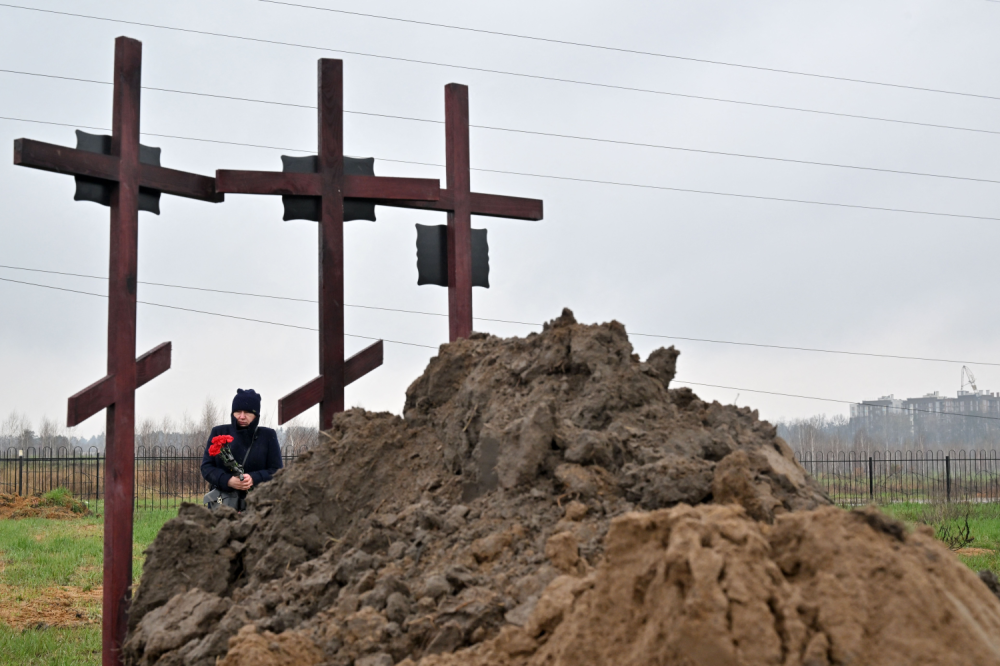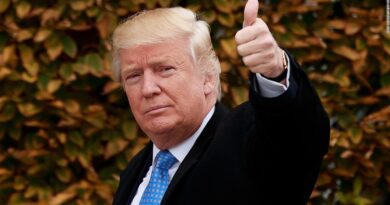Russia’s War Crime Denials Are Fuel for More Atrocities

On April 1, images of civilian corpses in Bucha, a suburb of Ukraine’s capital, Kyiv, began to spread on Western social media. By the following day, investigations by journalists, intelligence specialists, and disinformation experts had confirmed that the victims were almost certainly killed by the Russian forces that had occupied the town for a month before the Ukrainian army drove them out.
Russian state and social media, however, have presented an entirely different—and fundamentally mendacious—story. The creation of confusion and a false narrative around Bucha suggests that Russian President Vladimir Putin’s regime has no hesitation about twisting even the most abhorrent acts to throw oil on the fire. Russia’s own war crimes are being used to justify the committal of further war crimes; since the whole thing is a conspiracy against Moscow, Russian media hysterically claims, the war against foreign conspirators must be prosecuted to the bitter end.
Although bad strategic news is often ignored—the sinking of the Black Sea flagship Moskva, for instance, was dismissed, briefly acknowledged, then disappeared from view—unwelcome revelations of human conduct on the battlefield are almost always spun into outrageous stories.
On April 1, images of civilian corpses in Bucha, a suburb of Ukraine’s capital, Kyiv, began to spread on Western social media. By the following day, investigations by journalists, intelligence specialists, and disinformation experts had confirmed that the victims were almost certainly killed by the Russian forces that had occupied the town for a month before the Ukrainian army drove them out.
Russian state and social media, however, have presented an entirely different—and fundamentally mendacious—story. The creation of confusion and a false narrative around Bucha suggests that Russian President Vladimir Putin’s regime has no hesitation about twisting even the most abhorrent acts to throw oil on the fire. Russia’s own war crimes are being used to justify the committal of further war crimes; since the whole thing is a conspiracy against Moscow, Russian media hysterically claims, the war against foreign conspirators must be prosecuted to the bitter end.
Although bad strategic news is often ignored—the sinking of the Black Sea flagship Moskva, for instance, was dismissed, briefly acknowledged, then disappeared from view—unwelcome revelations of human conduct on the battlefield are almost always spun into outrageous stories.
The regime releases ludicrous and often self-contradictory tales of biolabs, chemical weapons, and British and U.S. influence that often go viral on Western social media, but Russian propaganda’s discursive center of gravity for eight years has been the story that Ukraine is a Nazi state. It is this center—which posits Ukraine as an enemy equivalent to Nazi Germany and therefore worthy of Russia’s ire as the country that won World War II—that justifies almost any moral transgressions.
When it came to Bucha, Russian media did not respond to the storm gathering in the West until knowledge of that story began to spread among Russian audiences, even though their commanders—and, presumably, their journalists on the ground—would have been aware of the massacred civilians left behind as the Russian army retreated. Beginning on the morning of April 3—two days after the news broke—Russian media and propagandists launched an information offensive. Barely mentioned until April 3, Bucha was now everywhere: Russian state TV personality Vladimir Solovyov, for example, posted about it 39 times in 24 hours on his popular Telegram account.
News agencies, newspapers, and other channels barraged their audiences with a spiraling and ever more lurid story explaining away the West’s version of events. The Telegram channel of Ukraina.ru, a state news service recently established to give updates on the Ukraine “special operation,” is indicative of the way the story developed in a series of “discoveries” and self-contradictions. Other state channels followed a similar arc:
- Early in the morning, the channel’s first post about Bucha suggested a small group of “Ukrainian forces” returning to the town had targeted “collaborators.”
- A mere nine minutes later, the channel hinted that most of the bodies resulted from Ukrainian shelling.
- Another 40 minutes on, the bodies had apparently only appeared two days after Russia left, so this was a plot to blame Russia for Ukraine’s crimes: “Who was in charge of the town during the two days since we left? The Ukrainians, obviously. But we, of course, get blamed for everything,” the post said.
- After a six-hour break, the channel returned to claim that the whole affair had been staged, comparing it to the purportedly faked atrocities in Syria—a favorite conspiracy theory of the Russian state’s mouthpieces—and accusing the British government of leading a psychological operation in Bucha.
- By late morning, the channel published an official Ministry of Defence statement claiming that “not a single incident of violence” had taken place in occupied Bucha and there was conclusive proof that the civilians had been killed only after Russian troops left.
- In the early afternoon, the story took its most extreme turn. A forwarded message from journalist and Moscow politician Andrey Medvedev suggested that since the West was comparing Bucha to the Srebrenica massacre, “the stakes are high. They’re going to try to keep breaking us. So we can’t back down one iota.” Medvedev then claimed that “all the articles about Bucha are already written, all the newspapers are already in press” and finally introduced the real culprits: Ukrainian “nationalist battalions.”
Within hours of the news about Bucha being broken to the Russian public, a limited account of “Ukrainian armed forces” killing some “collaborators” had been drawn into a story of fakes, provocations, and a Russia trapped by the West into battle with Ukrainian nationalists. In the following days, Russian media repeated and added to these themes over and over again, coalescing around the line that Ukrainian battalions killed civilians in retaliation for supporting Russian troops.
In response, the media and many social media users’ calls to prosecute war on Ukraine to the fullest extent possible and not accept any compromises or peace deals grew stronger. The conspiracies have become ever wilder. In the days following April 3, they drew into the Bucha fakes’ favored hate figures, such as Ukrainian presidential advisor Oleksiy Arestovych. Ukraine’s imagined crimes in Bucha have been compared to Auschwitz. The local population in Bucha has been blamed for not raising the alarm sooner.
All the while, however, the narrative circles back toward the phantom specter of Ukraine’s purported fascists and adopts ever more inflammatory language. By April 5, Russian Foreign Minister Sergey Lavrov was explaining in a TV address that Moscow viewed the Bucha affair as a “provocation” staged by the West to cause the breakdown of peace talks: What broke in the early morning of April 3 as a story about a small group of Ukrainian troops killing “collaborators” had become a global conspiracy against Russia.
The explosion of contradictory explanations for what happened in Bucha was not Russia’s panicked response to being caught. It was part of a time-worn pattern: Russian media and politicians slowly dismantle the truth and then replace it with a forgery. The process starts with the idea of wanting to ask questions about the event in question. Once enough doubt has been sown, Russian media then begin offering and hyperbolizing alternative explanations. Frequently, these are expressed as mere suggestions or hypotheses, since the truth is ostensibly unknowable.
Russia has applied this cynical tactic time and time again. For example, when Russian and Russian-backed fighters in east Ukraine shot down passenger jet Malaysia Airlines Flight 17, killing 298 passengers, the state media’s immediate response was to interrogate the obvious truth. To do so, they introduced fake characters, such as “Carlos,” an imaginary Spanish air traffic controller working in Kyiv who could prove Ukraine had downed the plane.
This fabulism lay nestled between preposterous theories that the plane had been pre-loaded with corpses or was an attempt to assassinate Putin. However, over time, a more stable Russian narrative—the Ukrainians did it, and the West used it as a chance to malign Russia—emerged. In Russia’s distorted narratives, historical and external forces are always aligned against an innocent Russia, which is forced to pick through fragments of reality to discover the truth of the provocations committed against it. Those provocations in turn justify whatever action Russia takes.
In the case of Bucha, what might sound like a grotesque effort to deflect blame away from Russia is in reality about positioning and submerging the Russian account of events in the occupied town within a larger narrative of supposed “denazification.” The idea of denazification has been a consistent thread woven through Russia’s deflections, fakes, and conspiracies around Ukraine since 2014. It is a notion that gives Russia permission to commit every moral transgression in pursuit of its goals.
The denazification narrative paints anyone who supports a sovereign Ukraine as an unrepentant Nazi or Banderite, a reference to supporters of Ukrainian nationalist leader Stepan Bandera, who collaborated with the Nazis during World War II. Efforts to undermine Ukrainian identity by painting it as besmirched by a peculiarly ethnic—even fascist—bent have been used since Ukraine first voted for independence in 1991 and during the Orange Revolution. However, such accusations accelerated in 2014 following the Revolution of Dignity that swept a new pro-Western government into power and sparked Russia’s intervention in the Donbas and annexation of Crimea. Putin set the tone during a speech in March 2014, when he justified his annexation of Crimea by claiming Ukrainians were intent on killing and expelling all Russians: “Everyone can already tell exactly what they will do next, these Ukrainian heirs to the Bandera ideology, to a man who collaborated with Hitler during World War II … they will try to create an ethnically pure Ukrainian state.”
Although the intensity of the nazification narrative has waxed and waned since 2014, it is the undercurrent in Russia’s story of modern Ukraine and thus created the context through which many Russians understand events today. In this warped version of reality, Russia’s denazification campaign is a logical, even predictable, consequence of the nazification of Ukraine that the Russian media has detailed for eight years. The argument may be fleshed out with largely fictional and often obscene examples from the front, but the context is broad enough to embrace and encourage a continual moral shock at what Russians encounter in propaganda.
The consequences of normalizing such a distorted view of events are devastating. They are designed to and can only give rise to further hysteria among the Russian elites and public. The denazification narrative has been a very long time in the making. Now, it is spiraling out of control, embraced by the Russian elites and at least a substantial swath of the Russian public. In this light, the Bucha slaughter will escalate rather than impede Russian savagery in Ukraine. It provides Kremlin media with an opportunity to use the horror of Russia’s own crimes to justify committing even more atrocities against Ukrainians in the name of an ever elusive yet stronger threat.


